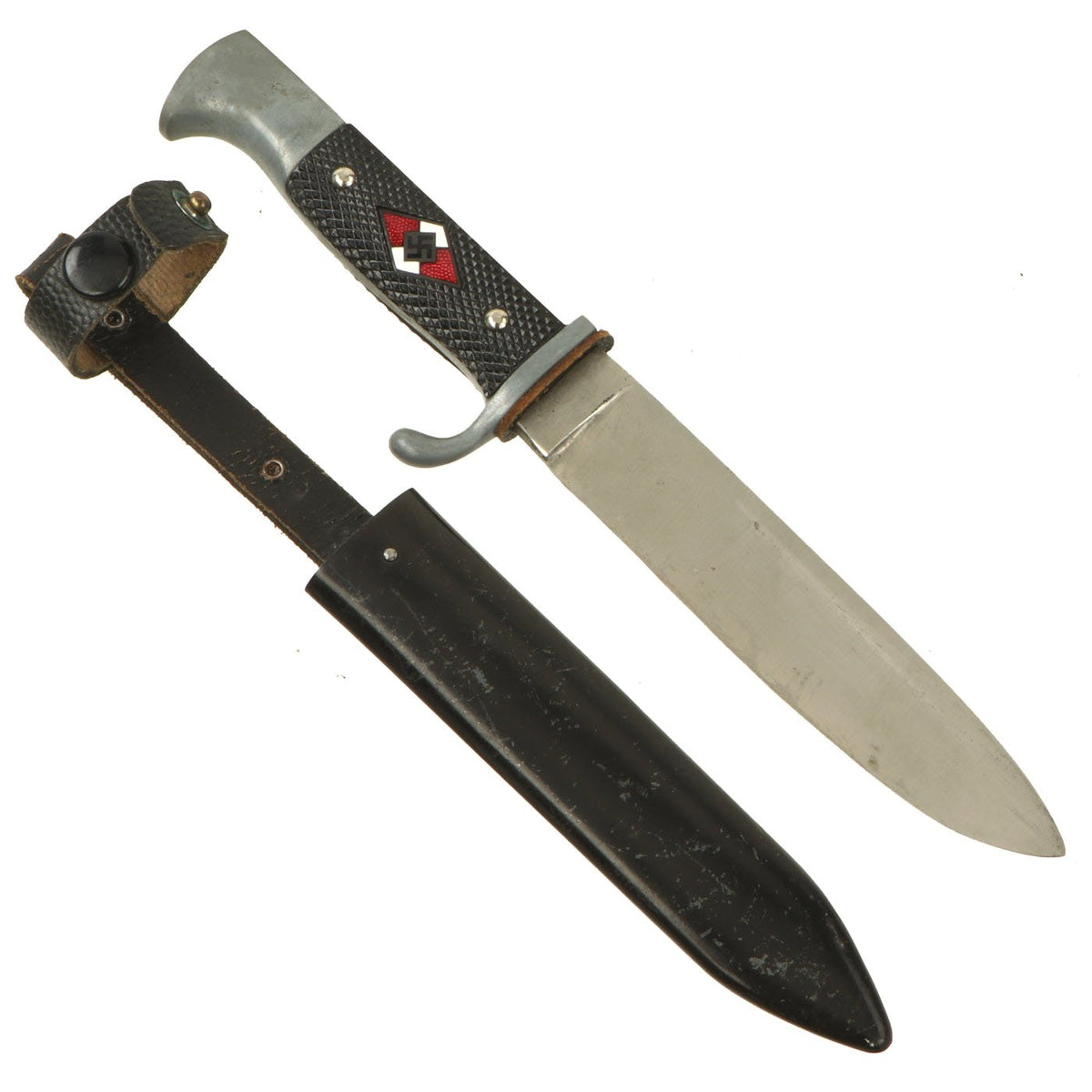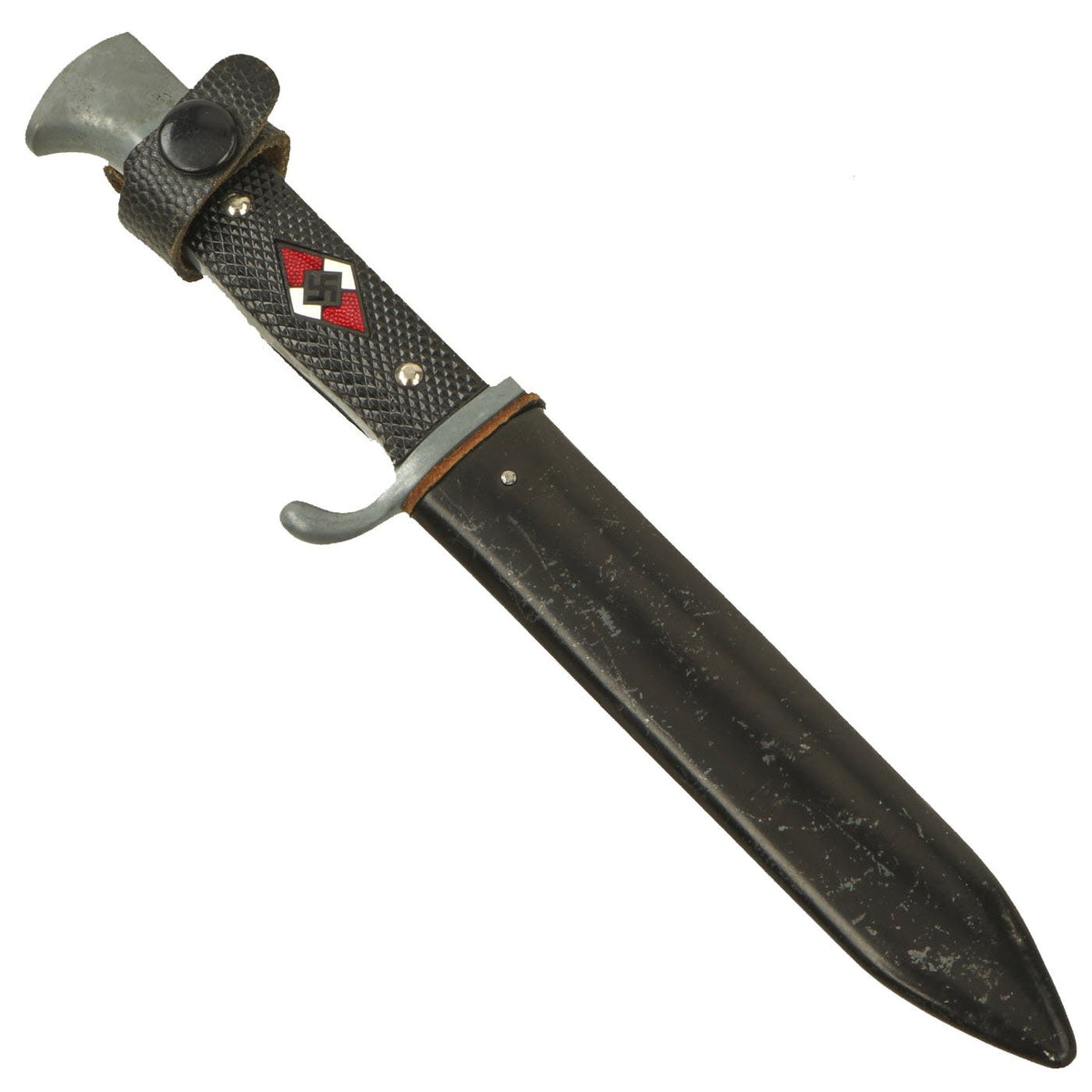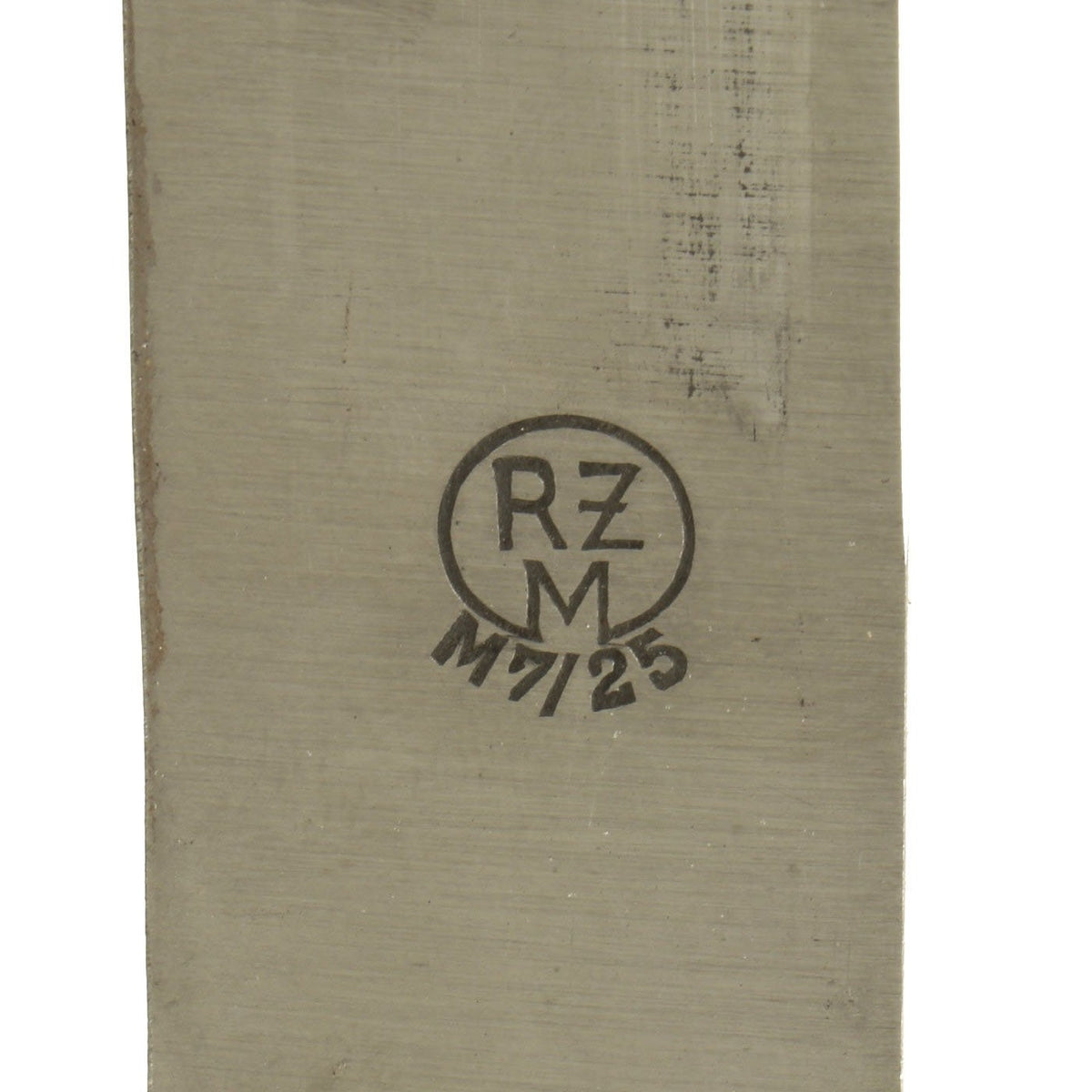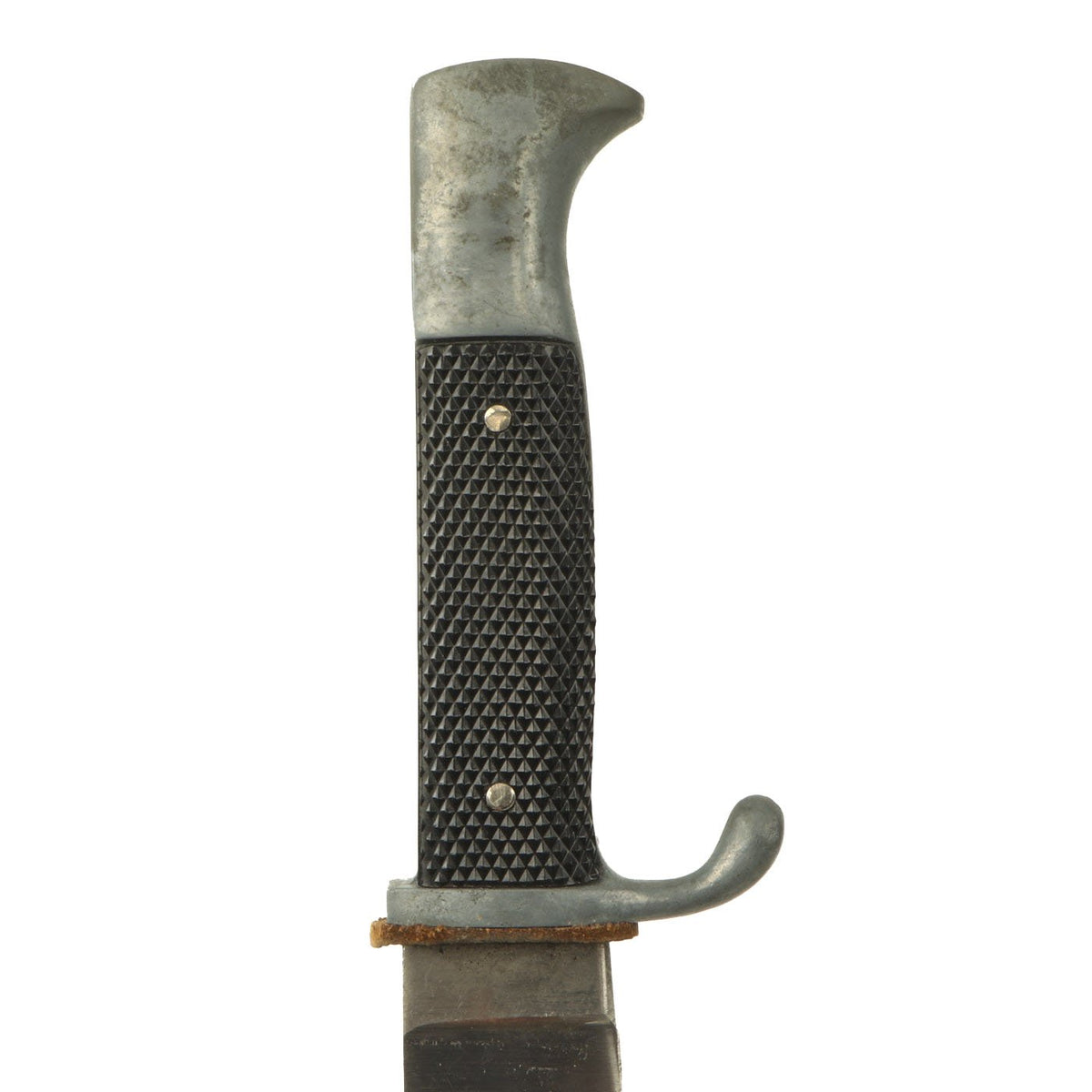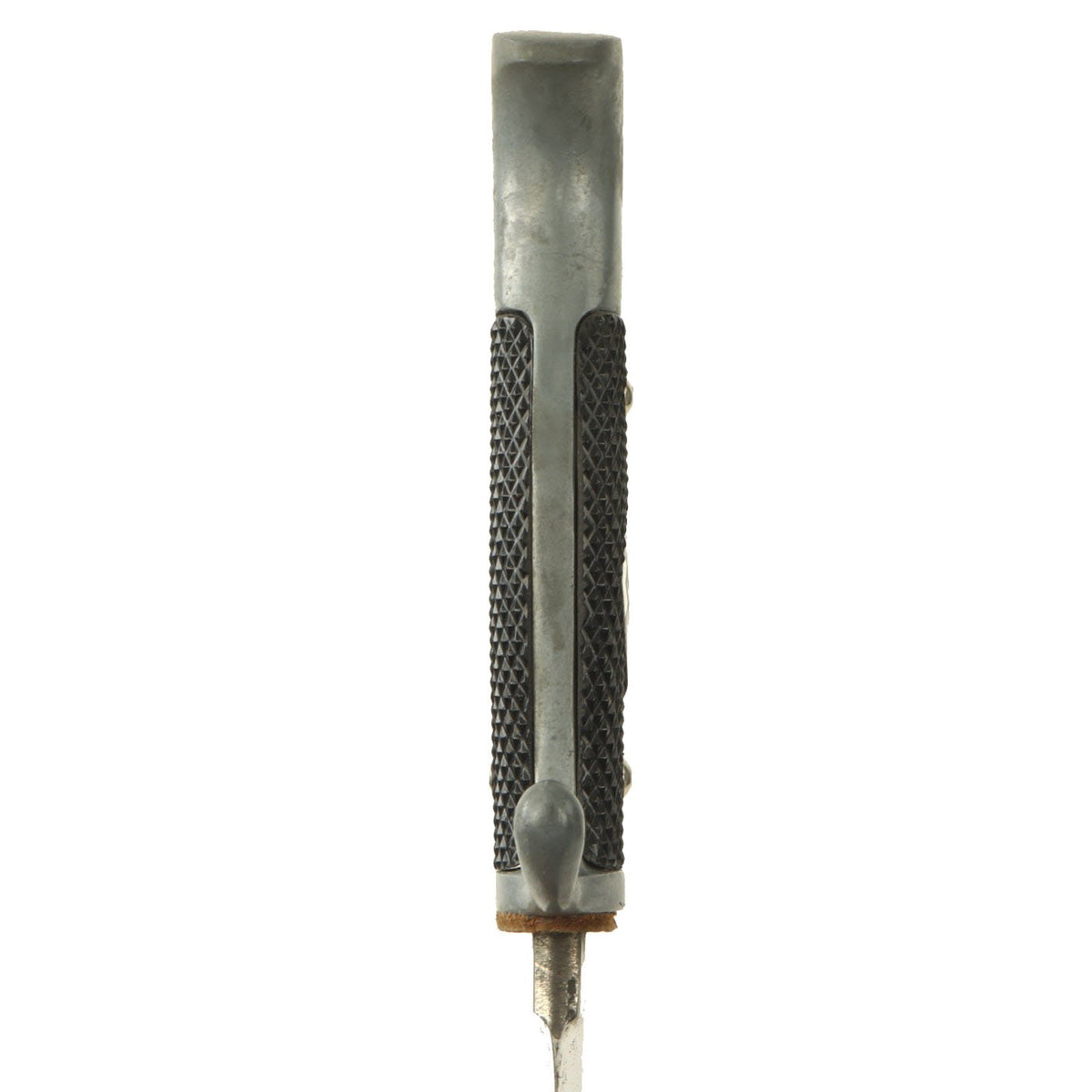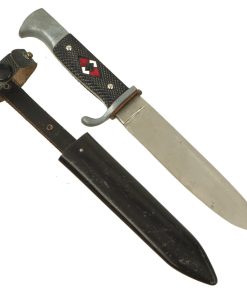Original German WWII HJ Knife with Scabbard by Wilhelm Wagner of Solingen-Merscheid – RZM M7/25 Original Items
$ 595,00 $ 178,50
Original Item: Only One Available. This is an excellent barely used example of the classic later pattern HJ Knife, produced by the rare maker Wilhelm Wagner, Stahlwarenfabrik (Steelware factory). Located in the Merscheid district of Solingen, the legendary “City of Blades” in Western Germany, this company was founded in 1876, and and manufactured a variety of cutlery and scissors before and during the war. They were listed as a maker of SA daggers and HJ knives during the war by Die Klinge, per J. Anthony Carter’s excellent book GERMAN KNIFE AND SWORD MAKERS. It comes complete with its original scabbard.
These knives were given to boys who were educated in the paramilitary organization, which they often continued to carry into their military service. Unlike the early pattern knives, these have a thicker blade with a raised ricasso, which significantly strengthened the blade. They also do not have the HJ motto etched on the blade, and often are marked not with a maker, but a German RZM Code.
The hilt of this example look to have been originally bare zinc alloy, as we can see no indication that they ever had any type of nickel plating, and they now have a lovely satin gray patina. The grip plates are the black checkered bakelite variety and are in excellent condition, with almost no wear, and definitely no cracking. They are retained by steel nickel plated rivets with dressed obverse heads, which have most of their plating. The enamel grip insignia has full enamel, though the brass borders between the panels are now an oxidized dark patina. It is loose in the grips, caused by the bakelite shrinking over the years, which also confirms authenticity.
The scabbard is completely straight throughout with no dents, and retains about 95% or more of the original black enamel finish. It has only light wear, though it does have a bit of crazing and checking that occurs over the decades. The belt loop is black finished leather, with most of the original finish present. It is smooth black finished leather, while the securing strap is pebbled leather. The rivets and snaps are all intact and fully functional.
The blade of this example is in excellent condition, and does not show much sign of being used or cleaned during the war. It still has full factory cross grain, with no sharpening or the other usual signs of use. Pretty much the only wear present is from the runners of the scabbard, so this example looks nearly unissued. The reverse side of the blade is somewhat faintly stamped with an ((RZM)) circle, over code M7/25.
The Reichszeugmeisterei, or RZM, was based at the Brown house in Munich and NSDAP party headquarters in Berlin. The RZM ensured that the manufacturers of military items were consistent in design, quality of materials and other characteristics of the items. It also defined standards of design, manufacturing and quality and published an authoritative color chart for textiles. The M7 in the code stands for knives/daggers, with Wilhelm Wagner being contractor number 25.
A wonderful HJ Knife in fantastic nearly unissued collectible condition!
Approximate Measurements:
Blade Length: 5 5/8″
Blade Style: Single Edged Knife.
Overall length: 9 5/8”
Crossguard: 1 7/8″
Scabbard Length: 5 3/4”
HJ believed German youth to be the future of his 3rd Reich. The HJ (jugend) was formed officially in 1935, and with the exception of NSDAP ideology indoctrination was very similar to the Boy Scouts. Beginning at about the age of ten years, both boys (jugend) and girls (Bund Deutscher Mädel) were enlisted in the Party-run organization. The boys only were given HJ Knives after having passed minor exams. The knives had nickeled hilts with black checkered grip plates. The obverse plate was fitted with an enameled HJ swas insignia. Through 1937, these knives were etched with the motto of the organization, Blut und Ehre! (Blood and Honor!). Examples produced after this date were made with plain blades usually bearing an RZM marking.
The HJ Leaders were professionals in charge of the training and NSDAP education of the German Youth. They wore a special dagger consisting of silvered hilt fittings with blue-black leather-covered scabbard. The grip was composed of tightly wrapped silver wire, over a wood base. The pommel cap featured an HJ diamond on top, complete with swas. The upper scabbard fitting portrayed an open-winged HJ eagle with swas cut into the bird’s chest. The blade was etched with the HJ motto, Blut und Ehre!
Fast Shipping with Professional Packaging
Thanks to our longstanding association with UPS FedEx DHL, and other major international carriers, we are able to provide a range of shipping options. Our warehouse staff is expertly trained and will wrap your products according to our exact and precise specifications. Prior to shipping, your goods will be thoroughly examined and securely secured. We ship to thousands clients each day across multiple countries. This shows how we're dedicated to be the largest retailer on the internet. Warehouses and distribution centres can be located throughout Europe as well as the USA.
Note: Orders with more than one item will be assigned a processing date depending on the item.
Before shipping before shipping, we'll conduct a thorough inspection of the items you have ordered. Today, the majority of orders will be delivered within 48 hours. The delivery time will be between 3-7 days.
Returns
The stock is dynamic and we cannot completely manage it because multiple stakeholders are involved, including our factory and warehouse. So the actual stock may alter at any time. It's possible that you may not receive your order once the order has been made.
Our policy is valid for a period of 30 days. If you don't receive the product within 30 days, we are not able to issue a refund or an exchange.
You can only return an item if it is unused and in the same state as the day you received it. You must have the item in its original packaging.
Related products
Uncategorized
Uncategorized
Uncategorized
Uncategorized
Uncategorized
Uncategorized
Armoured Fighting Vehicles of the World: AFVs of World War One (Hardcover Book) New Made Items
Uncategorized
Uncategorized
Uncategorized
Uncategorized
Uncategorized
Uncategorized
Armored Burgonet Helmet & Polearm from Scottish Castle Leith Hall Circa 1700 Original Items
Uncategorized
Uncategorized
Band of Brothers ORIGINAL GERMAN WWII Le. F.H. 18 10.5cm ARTILLERY PIECE Original Items
Uncategorized
Uncategorized
Uncategorized
Uncategorized
Uncategorized
Uncategorized
Australian WWII Owen MK1 Machine Carbine SMG Custom Fabricated Replica with Sling Original Items
